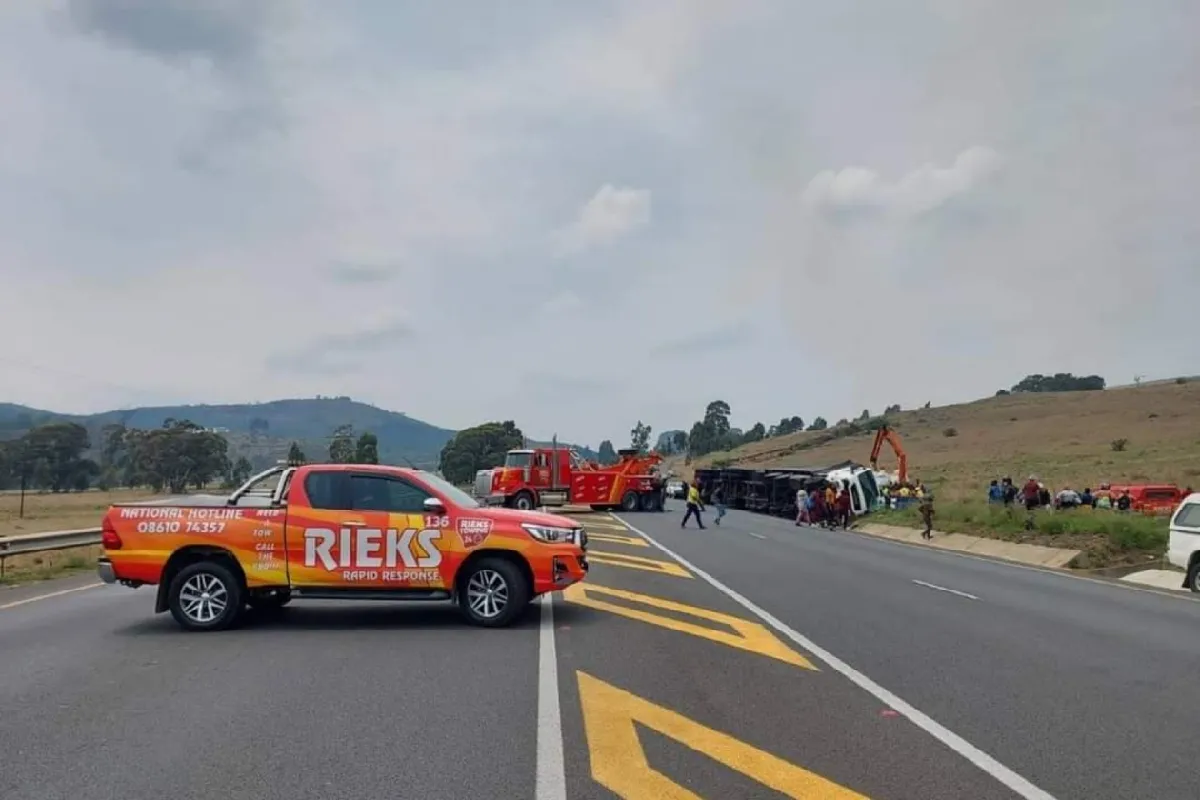
Single truck crash on N3
The N3 Toll Concession (N3TC) has released crash data for the first ten months of the year (January to October 2022) which reveals that there were 1023 vehicle crashes. Unsurprisingly, given the number of freight movement on the N3, the majority of these crashes (60%) involved trucks.
N3TC compiles the crash data to assist in the identification of possible road safety threats, and measures that could mitigate these risks.
Unskilled drivers and negligence
It’s worrying to learn that 79% of all light motor vehicle crashes and 85% of all truck crashes on the N3 Toll Route can be attributed to driver ineptitude and/or negligence.
Watch: Driver filmed steering truck with legs on the N3, while overtaking
As for truck crashes, fly-by-night trucking companies dominate the crash statistics due to them not training their drivers to reduce the risk of crashes.
The majority (62%) of the crashes recorded were single-vehicle crashes, where drivers lost control of their vehicles, and their vehicles either left the road or rolled.
On the road, high-risk behaviour and judgment errors come at a steep price. People suffer tremendous physical, emotional, and financial trauma as a result of the carnage on our roads.
Between January and October this year, the four most common types of crashes were vehicles that have rolled (23.3%); vehicles leaving the road (19.4%); damage to plaza infrastructure (14.7%); and head-tail (rear-end) collisions (13.8%).
Between 2019 and 2021, the number of truck incidents involving the arrestor beds on Van Reenen Pass increased by 46.4%. This trend continued in 2022 with a further 34 arrestor bed crashes recorded between January and October.
“Arrestor bed incidents are most often the direct result of vehicle mechanical failure. Efforts are underway to curb these incidents through regular vehicle inspections and active law enforcement by the KwaZulu-Natal and Free State Road Traffic Inspectorates,” continues Ms Dhoogra.
However, SA Trucker believes drivers’ lack of skill could be the cause of the increase in arrestor bed crashes. Drivers use the arrestor bed when their vehicles lose brakes while going downhill. The brake failure, according to SA Trucker, is mainly a result of reckless use of the brakes until they become inefficient.
If a driver overuses the foot brakes while going downhill, the brakes heat up and become inefficient leading to ‘brake failure’ and ultimately an arrestor bed crash if they are lucky to find one.
Brake failures, as explained in detail on the above link, are due to mechanical faults which are induced by the
Sharing the road responsibly
The increased volume of traffic and a mix of vehicle types sharing the same road increases road safety risks and impacts the number of crashes on the N3 Toll Route.

“Committed efforts are crucial to help reduce hazardous situations. It is a joint responsibility,” says Ms Doogra.
The speed differential between heavy and light motor vehicles is significant. The maximum speed limit for public transport vehicles is 100km/h, and for trucks, the limit is reduced even further to 80km/h. This often causes frustration for light motor vehicle drivers, especially when trucks cause congestion, slow them down, or attempt to overtake them.
It is important to remember that trucks and buses require longer stopping distances as a result of their mass, and they can easily jack-knife if forced to brake suddenly. The problem is further compounded by insufficient driver training, long working hours, driver fatigue, lapses in concentration, driver negligence and/or vehicles in poor mechanical order.
Never tailgate trucks and buses. Drivers cannot see vehicles travelling too closely behind them, in their blind spots. Stay well behind trucks and buses to avoid rear-end collisions, and only pass large vehicles if you are certain that the driver can see you in their side view mirrors – never from directly behind.
Extra caution is required around heavy motor vehicles in inclement weather and at night, or when visibility is poor. In wet weather, the splash and spray from trucks and buses make overtaking of heavy vehicles even more dangerous.
N3TC shares a few simple safety measures that can make all the difference and help to save lives:
- maintaining a safe following distance;
- adhering to the speed limit or reducing speed when travel conditions are poor;
- avoiding U-turns or overtaking on blind rises and solid lines;
- avoiding distractions;
- not using mobile devices while driving;
- always driving sober;
- and staying focused, alert, patient and courteous
“We appeal to all road users to make it your priority to reduce road safety risks. In this endeavour, we all have to play our part, from government and law enforcement officers to drivers and their passengers, and all logistics and freight operators. It is only through effective law enforcement, safety and security partnerships, preventative measures and swift multi-disciplinary action, when required, that safety and mobility on the N3 Toll Route can be ensured,” stresses Ms Dhoogra.





